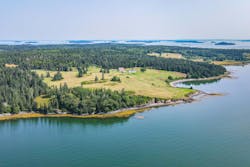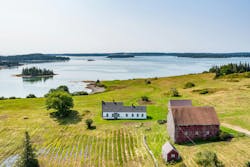Agents are setting the stage: In luxury markets with limited inventory, real estate agents are steering buyers toward land and custom builds.
Early collaboration matters: Projects thrive when builders, brokers, and clients align upfront on budgets, timelines, and expectations.
Local expertise reigns supreme: Builders with deep regional experience bring critical insight on permitting, site conditions, and feasibility.
Building a custom home has always been a highly personal process, but, increasingly, some of today’s most critical decisions are happening before a builder or architect are ever involved.
In a growing number of markets, real estate agents are acting as the early gatekeepers, advising clients not only on land selection, but also connecting them with the right team of professionals crucial to a successful project, from builders and architects to engineers and designers.
While not every transaction follows the same script, there’s a notable shift in second-home markets, where affluent buyers are purchasing second or third homes and treating them more like a primary residence and demanding higher levels of personalization.
This growing emphasis on lifestyle fit, combined with frustration over dated or limited housing options, is prompting many buyers to reconsider the idea of building from the ground up.
In response, luxury brokers are increasingly helping clients pivot from home shopping to land acquisition when suitable properties don’t exist and, in turn, recommending new clients to local builders.
In lifestyle markets across the U.S.—from the Mountain West to coastal Maine—builders are seeing a growing number of buyers make that pivot, driven by aging inventory, rising land values, and a desire for personalized, long-term living.
In Teton County, Wyo., for instance, top-producing agent Collin Vaughn, of Jackson Hole Sotheby's International Realty, says that dated inventory often prompts buyers to consider building.
“We have a lot of older inventory, and our inventory sits on really nice pieces of dirt,” Vaughn says. “I’ve got a client I've been showing for five years, and they can't find the right house. They don’t want something dated, and they don't want to remodel, but they haven't wanted to build. I think they’re realizing [their dream home] is not going to come up. “
That realization has become more common among lifestyle buyers in other markets such as Aspen, Colo.; Park City, Utah; Hawaii; and parts of coastal New England. In these regions, high-net worth buyers often want a home that supports multi-generational living, remote work, and long-term investment.
In Hawaii, that often translates to self-sufficiency and off-grid capability.
“There's been a big movement in buying large parcels because there's not much left [on the islands],” says Paul Stukin, founder of boutique brokerage Deep Blue Hawaii. “They want acreage, sustainability, solar farms, and agricultural systems. It’s a sense of security and pride of ownership.”
Many of these buyers are planning for long-term use, and with that comes a higher expectation of quality and vision. Rather than compromise on what’s available, they’re opting to build exactly what they want.
For builders, that means more incoming clients who are financially prepared but may need education about timelines, permitting, and land-use complexity.
Sometimes that education includes helping a buyer see the value in a property that isn’t turnkey-ready.
Jake Ankeny, founder of Ankeny Construction Management, Inc. in Jackson, Wyo., who builds multi-million-dollar homes in Teton County and beyond, advises buyers not to be afraid of a tear-down.
“I've seen a lot of clients that will look at a gorgeous piece of property with a really bad structure on it, and they'll get kind of turned off,“ he says. “My advice to them is, don't let that bother you."
A tear-down might cost $50,000 to $100,000, he says, "but if you're buying a $15 million property, that's nothing. Then you get to start from scratch."
If you're willing to live with the hassle and get exactly what you want, he says, that's where you can sometimes find value, and "buy something that isn't at the top of the market.“
Brokers as Matchmakers
For out-of-state buyers especially, the builder-client or architect-client relationship often starts long before any design discussions, with a recommendation from a real estate agent.
In these lifestyle driven markets, agents are increasingly acting as those early connectors, helping clients identify local professionals, including builders, engineers, and architects, who can bring their visions to life.
“You’re setting somebody up for a long-term relationship,” says Vaughn.
That match matters. A poor fit between a client and builder can derail a project before it even begins.
Joseph Sortwell, a real estate broker with LandVest Christie’s International Real Estate in Camden, Maine, who has been working in the region for more than 15 years, states that he always presents multiple builder options so a client can interview each and choose which firm fits their communication style, needs, and capabilities.
In these high-end markets, though, it’s rare for an agent or brokerages to formally partner with a single builder or architectural firm because “not one size fits all.”
Builder as Local Expert
A broker with deep local knowledge can be a valuable insider resource, especially in luxury and second-home regions where land deals can precede design decisions.
Some, like Sortwell in Maine, work closely with local engineers, builders, and architects on what is coming to market, while providing potential buyers with comprehensive land assessments to help the sales process.
For a recent 60-acre private island property off the coast of Maine, Sortwell hired an engineer to conduct the site work and analysis for environmental concerns and map out what could be built on the island and where. He also engages soil evaluators to assess each property, and works with architects and builders to provide preliminary renderings based on those evaluations, helping buyers better understand the full potential of the site before making an offer.
While this kind of broker involvement is on the rise, builders and architects still drive the project once it moves past acquisition, says Ankeny in Jackson. These relationships don’t pigeonhole builders into solely relying on real estate connections to attract new business—they simply expand the funnel.
Owning the Start
“Local builders know the land, the weather patterns, and the location of these properties,” Stukin says. “It’s also important to support the local community—a lot of these [firms] are second-, third-generation, or fourth-generation builders that have built an amazing reputation.”
When it comes to permitting, oftentimes the real estate agent will take a backseat and leave it to the builders, engineers, or architects. “These guys are pros,“ Vaughn says. “For me to question them would be like telling your doctor, 'Are you sure you do it this way?'“
As more luxury buyers enter the market looking to build, particularly in high-growth, high-amenity markets, builders are increasingly encountering clients who are motivated and well-funded but have already been shaped by their brokers' guidance and may arrive with incomplete information or unrealistic expectations.
That makes clear communication, planning tools and pre-design consultations more important than ever.
The Opportunity
For custom home building and design teams, the opportunity to benefit from earlier access to serious clients is twofold:
- Build stronger relationships with luxury agents who act as early influencers and strategic collaborators
- Establish a structured onboarding processes to better educate clients on timelines, permitting, and feasibility.
In high-amenity markets where expectations are rising and good land is scarce, builders who proactively align with the real estate side of the equation are positioned not just to win the work, but to shape it from the outset.
Join us in Austin: Registration is now open for our Women in Residential Construction Conference, taking place this fall in Austin. Join industry leaders and innovators for two days of networking, insights, and empowerment. Register here.
In Case You Missed It:
About the Author
Emma Reynolds
Emma Reynolds is a New York City-based freelance luxury writer who covers travel, real estate, design, architecture, and more. Her works has appeared in Forbes, Robb Report, Elite Traveler, Business Insider, Mansion Global, and many more.







